Friday 7 April 2017
Thursday 23 March 2017
Wednesday 22 March 2017
How to Analyze Your Instagram Marketing: 4 Metrics to Consider
Wondering how best to analyze your Instagram marketing?
Want to know which metrics will give you the most useful assessments?
Tracking the right Instagram metrics will help you identify successful marketing efforts and show where you can achieve better results.
In this article, you’ll discover how to analyze four important Instagram metrics.
#1: Calculate Conversions to See Where You’re Losing Prospects
The people who come to your website from Instagram are considered warm leads. It’s up to your website to convert them into hot leads, people who are almost ready to buy.
However, some leads become hot right on Instagram. People show they’re interested in making a purchase when they ask about the price or delivery options in comments or direct messages. Obviously, the numbers of inquiries and closed deals show how good you are at selling on Instagram. But they’re not enough if you want to sell more.
Suppose your business sells handmade bags on Instagram. Last year, you had 75 sales per month from an average of 180 Instagram direct messages and comments. Now you want to grow your business. To do that, you’ll need to hire another seamstress, which will increase your expenses. To meet your goals, you’ll need to close 114 deals instead of 75.
Should you publish more sales content on Instagram? Or grow your followers? Or create viral content and launch competitions to reach more people? A sales funnel can help answer these questions.
The people who have seen your Instagram photos but aren’t following your profile are cold leads. The people who saw your Instagram profile, loved it, and started following your account are warm leads.
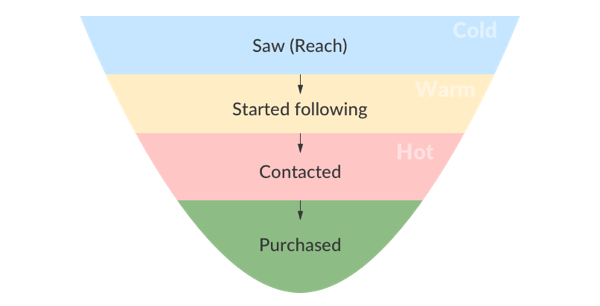
An Instagram sales funnel from cold to hot leads.
You’ll want to add the four stages of your sales funnel to your performance spreadsheet and fill in the relevant data. You can find data about reach and new followers in your Instagram Insights. To calculate the number of people who contacted you, total the number of incoming Instagram direct messages and comments valuable to your business (e.g., about price, delivery, etc.). This is your funnel.
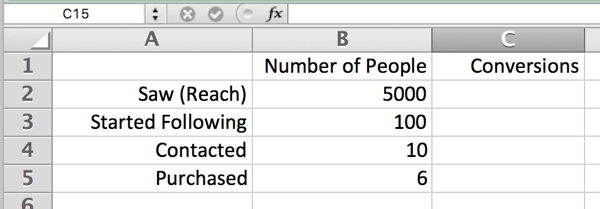
You’ll find reach and new follower data in your Instagram Insights.
How to Access Instagram Insights
To get access to Instagram Insights, you need to convert your account to an Instagram business profile. From there, tap the bar graph icon in the upper-right corner of your profile to see your analytics.
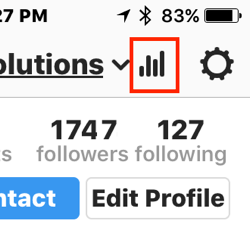
Tap the bar chart icon to access your Instagram Insights.
To find out where you’re losing prospects, calculate conversions at each stage of the funnel. For the Started Following stage, divide new followers by reach.
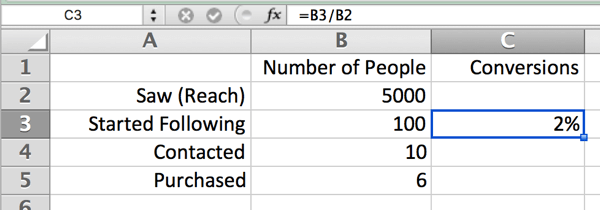
You can calculate the conversions of your Instagram sales funnel in your spreadsheet.
For the Contacted stage, divide contacts by new followers.

Divide contacts by new Instagram followers for the Contacted stage.
For the Purchased stage, divide purchases by contacts.
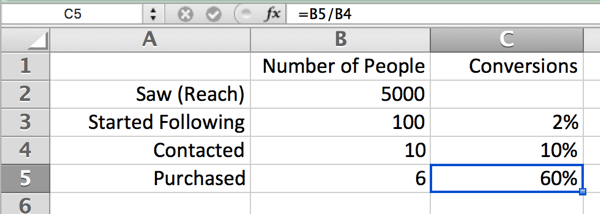
Divide purchases by contacts for the Purchased stage.
The sales funnel allows you to visualize a user’s path from cold lead to purchase. On your spreadsheet, you’ll be able to clearly see where your weaknesses are and the stages you need to optimize to grow your business.
Here’s the sales funnel for the example above:
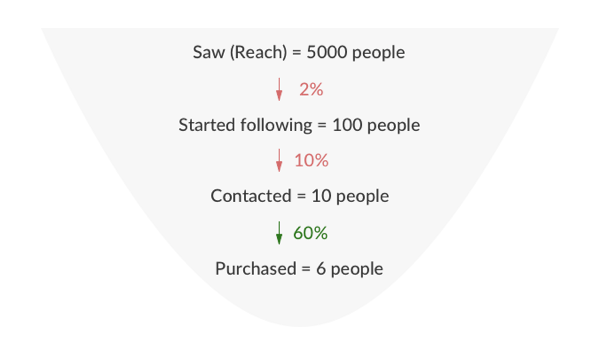
Look at conversions for each stage of your Instagram funnel to see where you’re losing prospects.
#2: Determine Follower Growth Rate to Benchmark Growth Goals
You can clearly see the number of followers above your Instagram profile’s bio. But what does that number really tell you about the growth of your community?

You can view your number of Instagram followers above your profile’s bio.
The number of total followers doesn’t mean anything in and of itself. Unsubscribed people along with newbies can slow the growth of your profile. Unexpected mentions and embedded posts can give you a brief rise in the number of followers.
To make it easier to track follower growth over time, use a tool like Google Sheets. To get started, add a row to your spreadsheet to track your total followers by month. The follower data in the example below reveals the audience is growing.

Add your total number of Instagram followers for each month.
Now you want to focus on how many new followers you’re getting each month. Add another line to your spreadsheet for new followers. To calculate this number, take the total followers for the month and subtract the previous month’s total followers. This gives you the total new followers for each month.

Enter your total number of new Instagram followers for each month.
Next, add a line to your spreadsheet for growth rate. To calculate this number, take the total new followers for the month and divide by the total followers from the previousmonth.
Here’s the formula to calculate follower growth rate:

Use this formula to calculate your follower growth rate on Instagram.
If you’re getting around the same number of new followers each month, it doesn’t mean you’re seeing stable growth in your community. In the example below, despite the same number of new followers each month (1200), the growth rate is decreasing.

Calculate the follower growth rate for Instagram.
The growth rate shows how fast your community is expanding and identifies which months you’ve performed best and worst. When you know the growth rate, you can set key performance indicators and better predict how many new people will follow you in the coming months.
If you don’t meet your growth goals, it’s time to analyze which factors are slowing growth. There can be different reasons for it, from irrelevant content (people are unfollowing your account) to low promotion (people can’t find you).
#3: Monitor Comment Engagement to Gauge Follower Sentiment
“Likes” on Instagram are an indication that people are interested in the content you publish. But how do you know what aspects of your content they like?
Take the Instagram post below as an example. Of the 317 users who liked this post, some might be interested in the company’s product (the puffy jacket), while others might be taken by the composition and color balance in the photo.
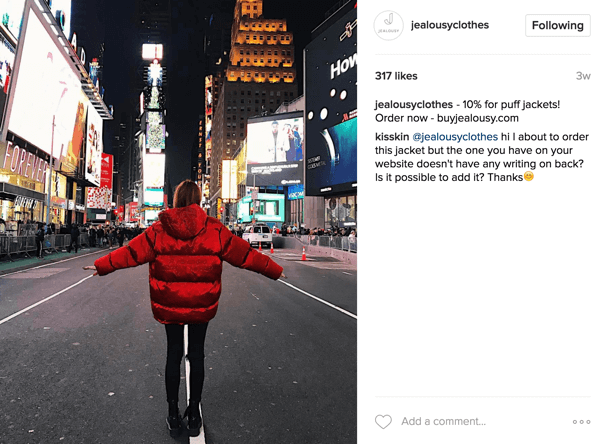
This Instagram post has received a lot of likes, but just one comment.
Remember, too, that a like on Instagram is an easy action. Users can just double tap the heart icon and then continue scrolling their feed.
Truly engaged followers, on the other hand, will applaud a photo through a comment. They’ll answer a question you’ve asked in your post. If you’re selling products, they may ask about the price and delivery in the comments.

Asking a question in an Instagram post can prompt comments from an engaged community.
Moreover, compared to likes, comments give more weight to your content and make it easier for people to find you.
Simply Measured is a free tool that allows you to track comments and other metrics on Instagram. You’ll get a comprehensive Instagram analytics report with valuable statistics in exchange for following the company on Twitter. It’s a good deal.
On the Simply Measured Engagement chart, you can see how the numbers of likes and comments have changed over time.
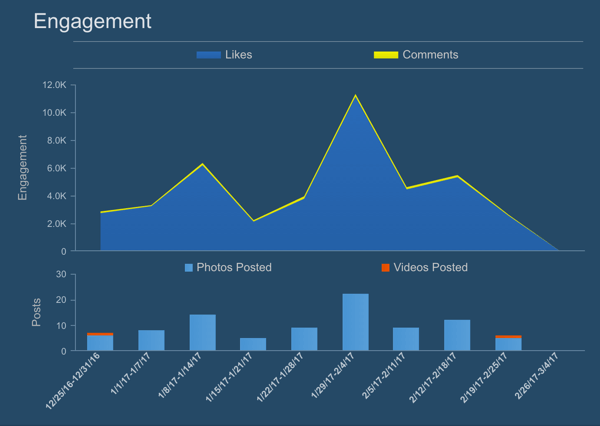
Simply Measured shows a graph of Instagram engagement (likes and comments) over time.
Even more important is to find out the average number of comments per photo (13.3 in the example below). Be sure to add this data to your spreadsheet. When you look at this number over time, you can see whether commenting is on an upward or downward trend.
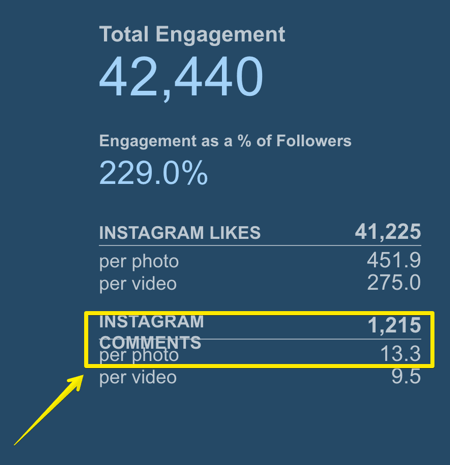
Track how many comments the average Instagram post gets with Simply Measured.
If you want to go a step further, analyze what people are writing in comments, as shown below. Be sure to add your Simply Measured engagement data to your performance spreadsheet. Choose a reporting period for downloading statistics and then add key numbers to your sheet.
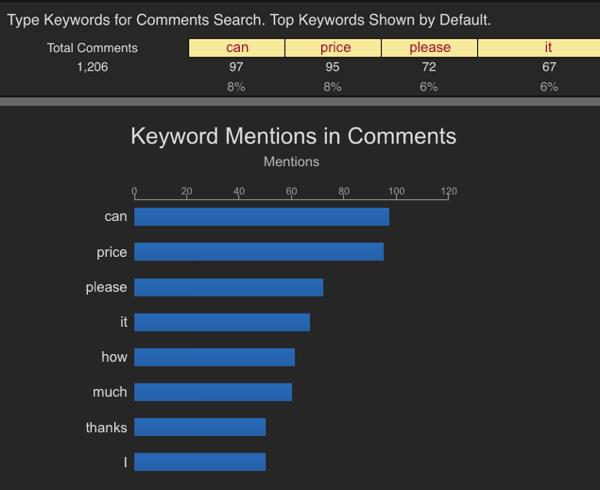
It’s important to track not only the quantity of Instagram comments but also their sentiment.
#4: Track Click-through Rate to Measure Referral Traffic
If you use Instagram to drive traffic to your website or blog, you’ll want to track clicks.
The easiest way to see total clicks is with Instagram Insights. Tap the bar graph icon in the upper-right corner of your profile. You can then see the number of times the links in your bio have been clicked for a specific time period.
If you want more detailed information, add Google UTM parameters to the links you share in your Instagram bio. Then in your Google Analytics, you’ll be able to see how many people clicked the link in the bio, what link they clicked, and what people did after that.
Add UTM parameters to your links to track Instagram referral traffic.
To access these stats in Google Analytics, go to Acquisition > Campaigns > All Campaigns.
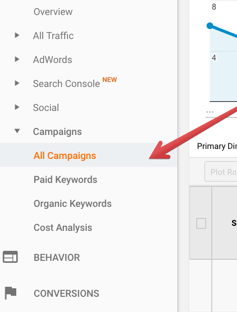
You can track UTM codes in Google Analytics.
Now you can see your traffic from Instagram.

View data about your Instagram referral traffic in Google Analytics.
What do UTM codes bring to your analytics? With UTM codes, you can calculate the click-through rate (CTR) for each link you share. The CTR is the ratio of users who clicked on a link to the number of users who saw it.
If you’re calculating CTR for Facebook posts, you simply compare the reach and number of clicks for each post. But on Instagram, you can’t attach clickable links to posts unless they’re ads. What you can do is change the links in your bio and refer users to your bio in your post.
So to calculate CTR on Instagram, take the number of clicks for a unique link divided by the number of people who viewed the post.

Use this formula to calculate CTR for each Instagram post.
Be sure to include a column for CTR on your performance spreadsheet.
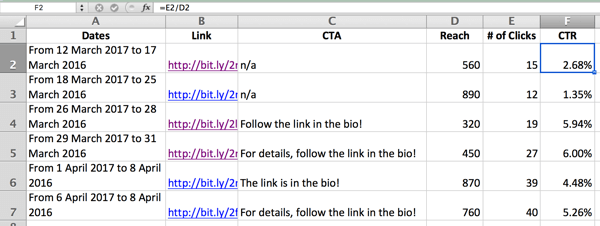
In your Instagram performance spreadsheet, note CTRs and conversions, as well as key factors that may influence them.
If you track goals in Google Analytics, you can also add information about completed goals such as purchases, video views, subscriptions, signups, and so forth. This lets you see how relevant the traffic you’re driving to your website is and whether people actually convert to customers.
Also, note the call to action you used in your post or any other factors that you believe influence CTR. This will help you develop a formula that encourages users to click the links you share.
Bonus: Monitor Hashtag Popularity to Identify Refined Hashtag Opportunities
When you’re choosing which hashtags to add to your Instagram posts, it’s tempting to pick the most popular ones.
However, if you use popular (high-volume) hashtags with the hopes of ranking high in Instagram search, your posts will need to be extremely relevant and have enough weight (comments and likes) to rank high. For these reasons, it’s difficult for small- and medium-sized businesses to compete with large businesses that use the same hashtags.
Small- and medium-sized businesses are likely to see better results with low- and medium-volume hashtags because there are fewer people searching for them. If you use the hashtag #flowerslondon, for example, you’re targeting a geographic location. With #flowertattoo, you’re targeting your audience by interests.
To research hashtags, use tools like Keyhole or Hashtagify. They’ll show you how often hashtags are used and allow you to compare them.
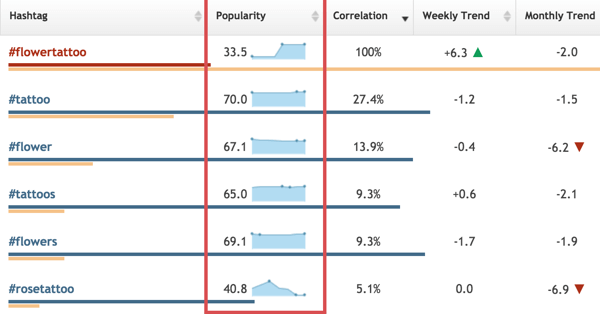
In Hashtagify, you can compare hashtags based on their popularity.
If the tool you use doesn’t offer statistics on hashtag popularity or volume, you can use frequency of usage as a base metric. The number of posts per hour metric gives you information about the time your post will be in the first section of recent posts, right below top posts.
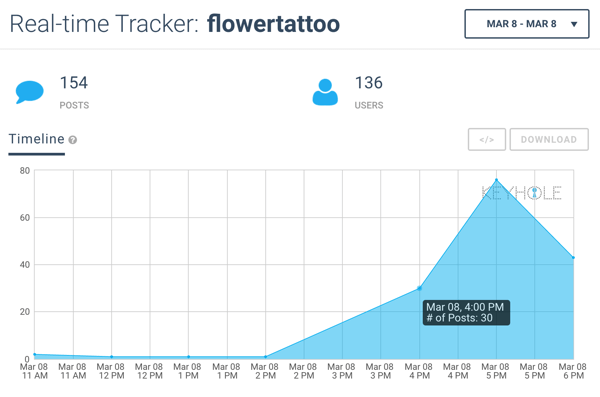
The frequency of usage metric can predict how long your Instagram post will be trending.
For example, if you choose #flowertattoo and your image doesn’t have enough weight to be ranked at the top, your post could still be among the first listed for the hashtag for a specific hour of the day.
These five metrics give you valuable insights into the effectiveness of your Instagram marketing and help you identify areas where you can improve performance on the platform.
What do you think? Do you track these metrics to evaluate your Instagram marketing performance? What additional analytics do you measure? Please share your thoughts in the comments below.
Tuesday 21 March 2017
3 Scientific Reasons Clutter Can Stress You Out
Last spring, SUCCESS contributing editor Melissa Balmain embarked on a personal journey through the en vogue doctrine of neatness apostle Marie Kondo. Balmain might not have emerged a devout “Konvert,” but she did considerably reduce the clutter in her home, and gained a noticeable boost in mental and physical energy.
(For those who missed the height of the craze, the concept is fairly straightforward: Sort through every item in your home by category, and if an object does not “spark joy”—or at least have a necessary function—let it go. Kondo’s minimalism manifesto leads off boldly with, “I have summed up how to put your space in order in a way that will change your life forever.”)
Kondo’s method went mainstream in the U.S. after the English release of her first book, The Life-Changing Magic of Tidying Up, in 2014. In a New York magazine profile, Kondo explains that the first of her two titles on the art of organization (the follow-up, Spark Joy, published in 2016) was intended as a temporary solution for a lengthy list of clients in Tokyo waiting for personal consultations. Both titles reached the top of the New York Times best-seller list, Fox and NBC have a sitcom about her in the works, and in 2015 she was named one of Time magazine’s 100 most influential people. It’s safe to say that KonMari, as she’s known, is the Beyoncé of decluttering.
I began noticing copies of the small book with its cloudy blue watercolor cover appearing with increasing regularity on friends’ coffee tables, and even on the desk of a fastidious uncle with a profound love for his label maker. Instagram posts popped up of pristine coat closets and sock drawers with captions involving the word “Kondo’d,” which somewhere along the way had become a verb.
I frequently purge the contents of my apartment, priding myself on fitting all holiday decorations into one (slightly bulging) box and waging a ruthless war against errant office papers.
Personally, I didn’t think I had a need for Kondo’s methods. Already a self-proclaimed “anti-hoarder,” I frequently purge the contents of my apartment, priding myself on fitting all holiday decorations into one (slightly bulging) box and waging a ruthless war against errant office papers. I didn’t give much thought to the cause behind my unflagging impulse to consolidate, and crossed my fingers that my significant other would continue to find it endearing when I hid sponges out of sight under the kitchen sink.
But recently I found myself on an unexpectedly long layover with no reading material, and the cloudy blue cover was in my direct line of sight on a backlit rack of best-sellers. It was a validating read; Kondo and I share a mutual aversion to old receipts and unsightly sponges, and her folding technique is spot-on (though I didn’t quite buy the personification of my socks). What I found most interesting, though, was poking into Kondo’s background—a habit when it comes to authors I enjoy. I learned that feng shui (the Chinese philosophy of achieving harmony with your environment) had been a major influence in Kondo’s study of neatness, and she was intrigued by the concept of creating “psychological distance.” In theory, feng shui can help avoid mental crowding through the careful arrangement of one’s possessions, which naturally pairs with Kondo’s minimalist methods.
Throughout her books, Kondo asserts that our bodies experience a physical and emotional reaction to tidying up. And it made me wonder: What’s the neurological effect of clutter on your brain?
1. It can (literally) hurt to let go.
In 2012, researchers at the Yale School of Medicine found that when individuals with hoarding tendencies were faced with discarding an object of personal value, two regions of the brain associated with conflict and physical pain showed greater signs of activity, the anterior cingulate cortex and the insula (the same areas that produce nicotine cravings). The stronger the connection to the possession, the greater the resulting feeling of psychological discomfort or anxiety.
Although most people don’t experience heightened ACC/insula activity to that degree, we can all identify with the feeling in the pit of your stomach when you finally decide to toss that pile of ancient bank statements or a Dave Matthews screen tee that shrank in the wash half a decade ago (both casualties of my latest sweep).
2. It can elevate cortisol.
According to David W. Ballard, assistant executive director of the American Psychological Association’s Center for Organization Excellence, many adults “operate in a state of chronic stress.” For some, coming home to a chaotic physical environment prevents the body’s cortisol (aka the “stress hormone”) levels from naturally declining throughout the day.
A 2009 study published in Personality and Social Psychology Bulletin found that women who described their households as “cluttered” exhibited increased fatigue and depression with correlating high cortisol levels, and a research project by UCLA in 2012 saw a similar link. Cortisol is bad news for healthy brain activity, as heightened levels of the hormone can cause lasting negative changes in brain function and structure.
3. It can affect your ability to focus.
An excess of physical clutter can overload the visual cortex, competing for attention in your brain and interfering with your ability to focus and process information. You might not realize it, but an overflowing laundry hamper, kitchen table piled with papers and overflowing junk drawer can subconsciously be on par with a whining toddler, distraction-wise.
In a study by the Princeton University Neuroscience Institute, researchers monitored task performance when an individual was surrounded by organized versus disorganized stimuli; overall, subjects were more productive—and less irritable and distracted—in the clutter-free environment. This one is especially relatable; though admittedly I’m on the more neurotic end of the spectrum, I have a hard time doing anything at home before straightening up my entire living space.
The mess threshold differs for everyone (some even encourage embracing the clutter), and for those with “chronic” disorganization, joy is sparked by chaos itself. But for me, there are serious psychological benefits to making that monthly Goodwill run—and my sock drawer has never looked better.
I Stopped Worrying, Then Happiness Showed Up
The formula for happiness is simple, right? Do things that make you happy, avoid negative thoughts and stress, and voila! Happiness appears like a beam from within and shines all around.
But that’s not at all how it happens. You know and I know it doesn’t work like that. And today, on the International Day of Happiness, the world is talking about how it does. How people, like you and me, can create more happiness in the world around us. And it starts with you.
Happiness works much like love, in mysterious ways. However, science and psychology tell us that brain chemistry alters emotion. But in order to activate those chemicals, we have to talk about habits first.
There is a formula to happiness, and it lies in changing thought patterns. Your patterns—what you do and think and say every day—determine how happy you are. It’s got nothing to do with what’s around you, but everything to do with how your brain works—that inner voice. Happiness is not within your grasp because it is, quite literally, within you.
Happiness: Arrivals & Departures
Happiness does not happen overnight. Duh, you know that, right? You don’t strike a yoga pose or two, meditate for a month or a year, write mantras on post-it notes all over your home, and poof, happiness arrives and is knocking on your front door. There is no doorbell-ringing happiness. Happiness is silence; it is stillness. But it’s hard to be so quiet and motionless with the world whirling around us and inside of us.
We live in the real world where the unexpected is probable and real things happen. Things like extra stressful workdays, fights with our partners, misunderstandings with friends and family, bad thoughts, negative body image days, everything goes wrong days, insomniac nights, self-doubt, worry and the like. It’s all a part of life. And for many of us, it’s the part that messes with our ability to find blissful states.
My Truth
I have lived in a world much like that one. But of all those sensations, it was worry that pushed me over the edge. Am I doing this right? When will I? How can I? What if?
The truth is, I was forever in states of disarray—balancing on balls that no longer wanted to support me, balancing on a scale that said I was too fat, balancing on a line that wanted to see me fall. And I didn’t realize life presented transitions to teach me about me, to assist in the evolution of self.
The prospect of seeing the blessing in a mistake didn’t occur to me; I continued to make them and break them and beat them down and fight them and run away from them until I was too tired to run anymore and had to sit down. And at the end of the day, I blamed myself. I was disappointed in myself, and on some days, I even hated myself.
The truth is I tried to keep myself too busy to notice those feelings. The negative stuff got under-the-rug or in-the-closet treatment; I trudged forward despite and in spite of. The busier I was, the less likely I was to notice that happiness didn’t dwell inside me, but rather it was something I thought could be bought or constructed.
I kept myself busy because I was unhappy, and I was unhappy because I was too busy to notice.
Time Will Tell
Busy is the life that most of us are all about. We are obsessed with time. Every second is accounted for; every moment is a chance to do something, anything. Don’t stop moving and don’t slow down. Just keep going, keep pushing, harder, faster. Time’s a-ticking.
But because we’re so busy being busy, we don’t have time for much of what we love or like, and we rarely, if ever, have time for self-care.
We fall in and out of habits so quickly because we don’t always dedicate time to self—to things that are worthy, that foster happiness, things that burgeon happiness into a forest of self-love. Why can’t we stick to those positive habits that are tough at first, but ultimately have life-changing and life-affirming results? Why are we likely to stick to habits that make us feel like crap rather than the ones that lead to happiness?
This sounds like self-sabotage. But it also sounds like impatience.
Patience Is a Virtue
However, the enigma isn’t so enigmatic—we are a society full of instant everything. If whatever we desire doesn’t happen immediately, we don’t want it. Or maybe we want it, but we don’t want to wait for it, put in the effort, enjoy the process to reap the benefits. We want it now, dammit. We want it now! We. Want. It. Now.
Look at how we live, from the convenience of food, entertainment and quick-fix promises sold with the intention of giving you a flatter stomach, a wrinkle-free face, more room in your closet, flawless eyebrows and slimmer thighs. Without any effort, we have everything our hearts want and desire, and then some. Most of the stuff, we don’t even want. Look around your home, look at your life. Is it the life your dreams are made of? Or is it one that was sold to you?
Take the time to observe what’s around you. Is it what makes you happy? If not, how can you change it? If it doesn’t serve a purpose or make you feel all the feels, get rid of it. You do not have time for filling up space around you while your interior stays empty. Fill the inside, have experiences, feel.
Take the time to consider your activities. Do you do things that bring you joy? If not, why not? And why do you dedicate time to things that make you miserable? Integrity matters here.
Take the time to be still. Ask yourself some serious questions about what you want out of life and who you want to be. If you don’t look within, happiness will only be a mirage, a production of cinematographic proportions. Be mindful of what it is you long for and be honest about it. Reflection must be included in the process, period—there’s no way around it.
The Sound of Happiness
When I slowed down, things changed. I asked myself hard questions, and I let time give me the answers.
I didn’t pressure myself, not like I used to anyway. I sat still and listened to myself breathe and listened to others breathe and listened to the universe breathing, as if in unison with us all. Because that is what the universe does, it breathes with us and it gives us breath.
When I sat still, I could hear what I needed to hear. I started to really notice things. I became a non-robot. I became human again.
When I sat still, I could hear what I needed to hear. I started to really notice things. I became a non-robot. I became human again. And I was both afraid and amused. I finally realized that this was living.
Are you willing to be still, too? To be mindful? Are you willing to face the silence and hear happiness whisper all sorts of secrets in your ear? Be ready, or get ready, because those secrets can help you maintain your true self and push your levels of happiness higher than you ever thought possible.
Trust me, you want to sit still. You want to be quiet. Because when you slow down and sit still and listen, you can begin to feel happiness.
Monday 20 March 2017
Winning the War Against Complacency
When I sat down with our cover guy, Jocko Willink, to interview him for the SUCCESS Talks podcast, I started with an icebreaker. He had just finished a photo shoot managed by our art director, Amy McMurry, and I asked how it went. I told him that I hoped he enjoyed it and that, most importantly, I hoped he was able to stay on Amy’s good side, because she’s a brawler.
Now Amy is decidedly not a brawler. She’s about 5-foot-2 and tiny, a mother of two kids and the sweetest person you’ll ever meet. The irony was obvious. Jocko—a physical beast who would be the world’s greatest bouncer were it not for a higher calling—got the irony. But he didn’t have time for courtesy laughter. He didn’t even respond. It was obvious he didn’t care for games and formalities. Not being a brawler myself, I quickly got started with the interview.
Lessons on willpower, grit, self-motivation and leadership run throughout this, The Toughness Issue of SUCCESS.
This guy is different, I thought. He’s not just some author or speaker, although he’s both of those things. He’s so much more, though. He actually lives the lessons he teaches. Serving in the Navy SEALs for more than 20 years, Willink justifiably could be called one of the greatest warriors to ever live, and he brings the same unbreakable determination needed on the battlefield to his everyday life. He fights to be his best self. He’s not battling the mujahedeen or Iraqi insurgents anymore. Today his opponents are things like shortcuts, temptation and complacency.
And he’s pretty clearly winning the war. It’s such a massacre, in fact, that we wanted to share his personal methods and mindset to help in your own war against the obstacles to the life you want. Lessons on willpower, grit, self-motivation and leadership run throughout this, The Toughness Issue of SUCCESS.
Alongside Jocko we profile one of the world’s most rugged athletes, the boldest cowboy in professional bull riding. We sent Associate Editor Jamie Friedlander to the streets of Chicago to meet people living amid the worst violence in our country and making it their daily purpose to stop the shootings. There are guides for maximizing your mental toughness so you can crush any challenge that comes along, and for getting the most out of your team, even when it means you have to be a firm leader. And be sure to read the story of Managing Editor Jesus Jimenez tackling the most ambitious goal of his life, only to realize it’s not the goal that propelled him but the propulsion itself.
We always encourage you to be thankful for what you have and to enjoy each moment. Spring is a time of renewal—of stopping and smelling the flowers. But this month we’re challenging you to take a hard look at the whole garden. To put in the sweaty, aching work of pulling the weeds. And to plant more flowers.
A lot of hard work went into this month’s magazine. But that has only made us better and more energized for the next one. When you finish this issue and turn your attention to the battles to come, we think you’ll feel the same way.
Subscribe to:
Posts (Atom)



